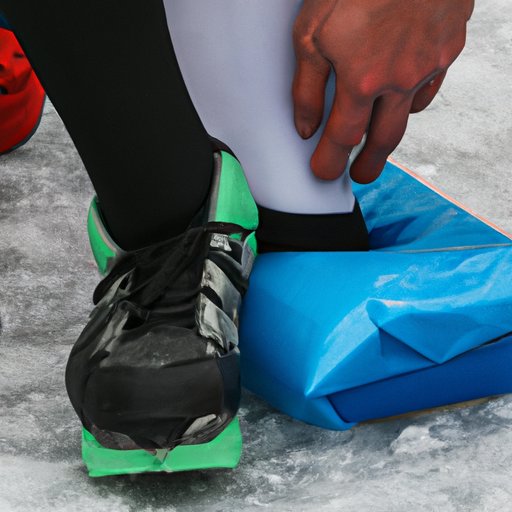
I. Introduction
Shin splints can be a painful condition for runners and athletes that results from intense physical activity. The condition is characterized by pain in the lower leg that can make it difficult to continue exercising. If you’re an athlete or runner, it’s important to know how to avoid shin splints so you can stay active and healthy. This article will outline some tips for preventing shin splints, including selecting proper footgear, increasing training gradually, stretching muscles, cross-training, using ice therapy, and seeking professional help when necessary.
II. Start with proper footgear
One of the primary ways to avoid shin splints is to wear proper footwear while exercising. Good running shoes can reduce the risk of shin splints by providing the right amount of support and cushioning to your feet.
When selecting a pair of running shoes, look for shoes that provide stability, cushioning, and support for your feet. The right shoes can help distribute the impact of your feet hitting the ground more evenly and reduce the strain on your lower leg muscles.
III. Increase training gradually
Starting with too much intensity too quickly can lead to shin splints. As you increase your exercise intensity, make sure to do so gradually.
One way to create a training plan that gradually increases exercise intensity is to use the 10% rule. This rule suggests that you should increase your exercise intensity by no more than 10% per week. This gives your muscles enough time to adjust to the increased pressure and reduces the risk of injury.
IV. Stretch your muscles
Stretching before and after exercise is important for preventing shin splints. Stretching helps to warm up your muscles and prepare them for exercise, as well as prevent muscle injuries and strains.
Some recommended stretches for the calf, hamstring, and hip flexor muscles include:
- Calf stretch: Stand with your hands against a wall and one foot behind the other. Keep the back leg straight and push the heel towards the ground. Hold for 15-30 seconds and switch legs.
- Hamstring stretch: Sit on the ground with your legs stretched out in front of you. Lean forward and try to touch your toes, holding for 15-30 seconds.
- Hip flexor stretch: Kneel down on one knee and step forward with the opposite foot. Push your hips forward to feel a stretch in the groin area. Hold for 15-30 seconds and switch legs.
V. Cross-train
Cross-training can help reduce the risk of shin splints by giving your muscles a break from the high-impact exercises associated with running or other high-intensity sports.
Low-impact workouts that are good for cross-training include swimming, biking, and yoga. By incorporating these exercises into your routine, you can strengthen different muscle groups and reduce the risk of injury.
VI. Use ice therapy
If you do experience shin splint pain, ice therapy can help reduce swelling and discomfort. Apply an ice pack to your lower leg for 15-20 minutes several times a day until the pain subsides.
Make sure to use a cloth or towel between the ice pack and your skin to prevent skin damage. It’s also important to avoid using heat therapy on shin splints, as heat can exacerbate inflammation and cause more pain.
VII. Seek professional help
If you’re experiencing severe pain or recurrent issues with shin splints, it’s important to consult a physician or sports injury specialist. They can provide a thorough diagnosis, as well as recommend different treatment options to address your particular situation. Treatment options may include physical therapy, orthotics, or other medical interventions.
VIII. Conclusion
Shin splints can be a frustrating and painful condition for runners and athletes of all levels. But by taking precautions such as selecting proper footwear, gradually increasing training intensity, stretching muscles, cross-training, using ice therapy, and seeking professional help when necessary, you can reduce the risk of shin splints and enjoy a more active, healthy lifestyle.
Remember to listen to your body – if you’re experiencing pain or discomfort, take a break or modify your exercise routine. And always prioritize your health and well-being as you pursue your fitness goals.





